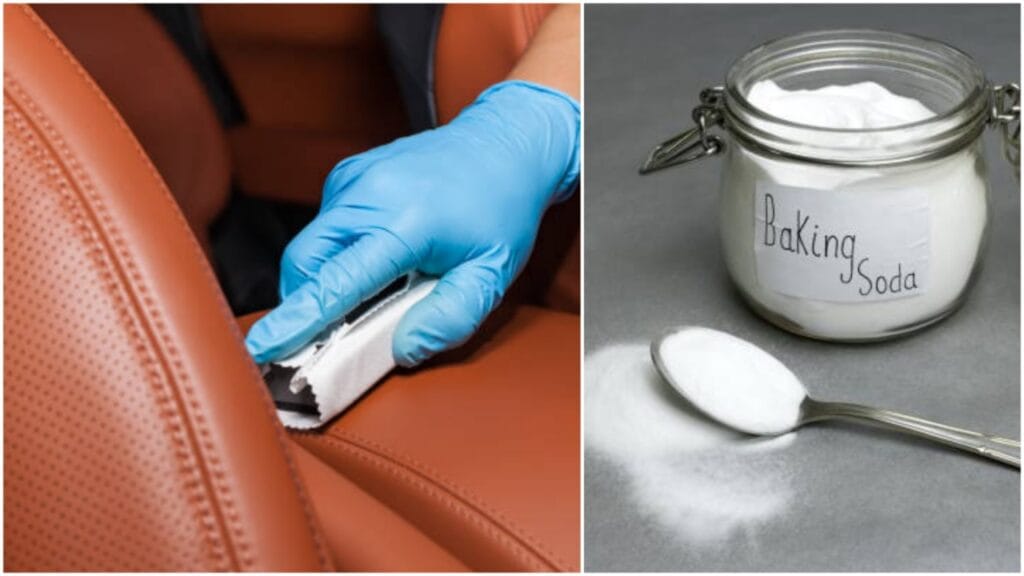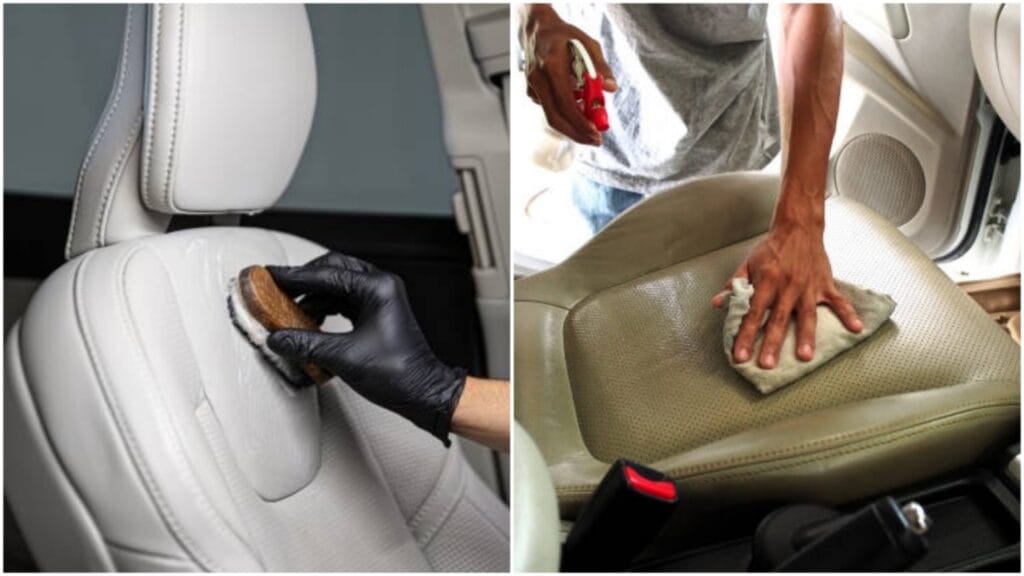Start by vacuuming the seats thoroughly. This removes dust and debris that can trap odors. Next, mix a solution of equal parts water and white vinegar in a spray bottle. Lightly mist the leather surfaces, ensuring not to soak them. The vinegar helps neutralize odors.
After applying the solution, wipe the seats with a clean microfiber cloth, buffing them gently to avoid damage. For more challenging smells, sprinkle baking soda on the seats and let it sit overnight. Baking soda effectively absorbs odors. In the morning, vacuum up the baking soda.
You can also use a specialized leather cleaner with odor-eliminating properties. With these steps, you can enjoy a smoke-free environment in your car, making your driving experience more pleasant. Please tell us more about this and try to understand in detail why this smell happens.
Understanding the Source of the Smell
Smoke clings to surfaces like a persistent shadow. Leather, with its porous nature, absorbs scents and particles. When someone lights up, the smoke isn’t just floating away.
It settles deep into the fibers, embedding itself in the leather’s structure. The chemicals in smoke—tar, nicotine, and ash—form a cocktail of odors that become trapped over time.
The sun’s warmth can exacerbate the situation, opening up the leather’s pores and deepening the smell.
Assessing the Damage

Assess the extent of the smell. Does it hit you like a brick wall whenever you open the door? If it’s a hint, you can breeze through this with some light cleaning.
But if it’s overpowering, brace yourself. A more thorough approach will be necessary.
Gather Your Arsenal
It’s time to gather your tools. You don’t need anything extravagant, but a few simple items will work wonders. Look for a quality leather cleaner. This will be your first line of defense.
A soft brush is also essential for getting into those creases. And don’t forget white vinegar or baking soda—both are natural deodorizers.
Start with a Clean Slate
The first step in banishing that odor is to clean the leather. Grab your leather cleaner. Spray onto the cloth, not directly onto the seat. Gentle circles are your best friends here.
Focus on the areas that seem most affected. The goal is to remove any surface grime harboring the smell. This step cleans and prepares the leather for more profound treatment.
The Vinegar Solution
Vinegar can neutralize odors. Mix equal parts of white vinegar and water in a spray bottle. Lightly mist the solution onto a clean cloth, not the leather directly.
Wipe down the seats with this cloth. The smell will intensify momentarily and then dissipate as the vinegar dries.
Baking Soda to the Rescue

If the smell lingers like an unwanted date, It’s time to use baking soda. This powder has been a deodorizing hero for ages.
Sprinkle a generous amount over the leather seats and let it sit overnight. Baking soda absorbs odors. In the morning, vacuum it up.
Let Fresh Air In
Sometimes, nature offers the best remedy. Open those windows and let fresh air flow through. If the weather permits, leave the doors open for a while.
The wind can carry away some of that persistent odor. It’s a simple yet effective way to refresh the atmosphere inside your car.
Commercial Odor Eliminators
When home remedies don’t work, consider commercial products. Various sprays are specifically designed to tackle smoke odors. Look for enzyme-based products.
They work by breaking down the compounds in smoke that cause the smell. Before applying the product, follow the instructions carefully and ensure it is safe for leather.
Keep It Ventilated
Prevention is key. Once you’ve successfully removed the smoke smell, please take steps to make sure it doesn’t return. Regularly ventilate your car.
If you smoke, try to do so with windows down. An air freshener can help mask odors but is no substitute for proper cleaning.
Protect Your Investment

Leather requires care and attention. Consider investing in a leather conditioner. This helps maintain the leather’s integrity while providing a barrier against future odors.
Conditioning creates a protective layer that can affect how your seats react to environmental factors.
Stay Vigilant
After your hard work, stay vigilant. Smoke odors can return if the source is still there. If you’re around to smoke regularly, commit to cleaning your seats more often.
Regular maintenance can prevent those stubborn smells from retaking roots.
The Emotional Aspect of the Smell
It’s not just a smell; it carries memories. For some, it evokes nostalgia for good times, while for others, it reminds them of bad habits.
Whatever the case, the scent’s emotional weight can linger, adding another layer to our reasons for wanting to eradicate it.
Enjoy the Journey Ahead
You can enjoy your ride again once you’ve tackled the smoke smell.
There’s something liberating about a clean, fresh-smelling vehicle.
You’ll feel lighter as if a weight has been lifted.
Final Thoughts

Understanding why the smell lingers is just as crucial as the techniques used to remove it.
You can reclaim your space and create an enjoyable environment with the proper knowledge and tools.
FAQ’s
How do you get the smoke smell out of the car with vinegar?
Vinegar is a powerful way to remove smoke smells from a car. Start by mixing equal parts white vinegar and water in a spray bottle.
Lightly mist this solution onto a clean cloth. Avoid spraying directly onto surfaces. This is especially true for leather or fabric, as vinegar can be potent.
Wipe down the seats, dashboard, and other hard surfaces with the cloth. Vinegar is a natural deodorizer that helps neutralize the smoke odor instead of covering it up.
It’s an easy, affordable trick that works wonders for a fresher-smelling car.
Will car detailing remove the smoke smell?
Yes, car detailing can help remove smoke smell, but it depends on how thorough the service is. Standard detailing includes a deep clean of surfaces, carpets, and upholstery.
This process can make a big difference if the smell of smoke is manageable. Professional detailers use specialized cleaners and tools to penetrate surfaces and lift odors.
Many detailing services also offer odor-eliminating treatments. They use ozone generators or enzyme sprays. These treatments break down smoke particles. They neutralize the smell rather than masking it.
If the smoke has existed for years, more than a single detailing session is required. A single session is also inadequate if the smoke is deeply embedded in the car’s fabric and vents.
A more extensive service or even multiple treatments is required in such cases. Detailers with skills in odor removal can assess how much work is needed to freshen up the car fully.
Detailing is a great start. Yet, the intensity of the smell will decide the results, and the detailing approach will also influence the outcome.
How do you get the cigarette smell out of the car with leather seats?
Smoke particles cling to leather, so grab a high-quality leather cleaner and a soft cloth. Never apply the cleaner directly to the seats; use it to the fabric instead.
Wipe down every inch of the leather using small, circular motions. This helps lift surface grime and smoke residue. After cleaning, mix a solution of equal parts white vinegar and water.
Lightly dampen a new cloth. Gently wipe the seats to neutralize the smell. Be careful not to soak the leather; it only needs a light touch.
Once dry, sprinkle a small amount of baking soda around the car and let it sit overnight. Baking soda absorbs lingering odors from the air and upholstery.
You can keep that cigarette smell away with regular ventilation and occasional cleaning.
How can you get the smell of smoke out of car seats?
First, vacuum thoroughly to remove any loose particles from car seats. These particles can hold onto odors.
Then, use an upholstery cleaner suited for your seat material—cloth, leather, or vinyl.
Spray the cleaner onto a soft cloth and work it into the seats. Focus on any areas where the smell is most potent.
Mix equal parts white vinegar and water in a spray bottle for an extra odor-fighting boost. Lightly mist a cloth and use it to wipe down the seats.
Conclusion
Removing the smoke smell from car seats takes effort, but the results are worth it. You can combine simple household items like vinegar and baking soda with a good upholstery cleaner.
This mixture will effectively neutralize the odor and freshen up your car. Remember, smoke particles can be stubborn, so patience and thoroughness are key.
With these steps, you’re not just masking the smell but breaking it down. Plus, keeping your car ventilated and clean helps maintain that freshness long-term.
Routine care can make your car smell pleasant, making every ride more enjoyable.

